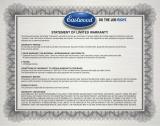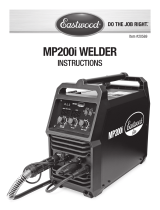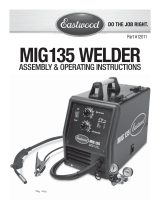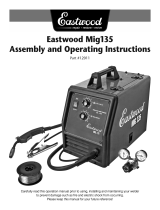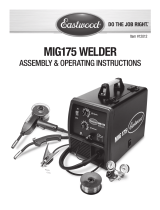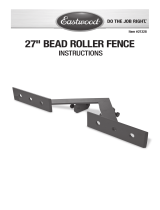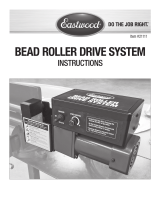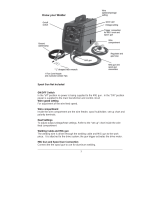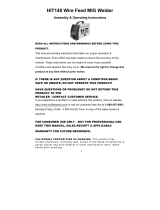Page is loading ...

MIG135 WELDER
INS TRUCTIONS
Item #12011

2 Eastwood Technical Assistance: 800.343.9353 >> techelp@eastwood.com
STATEMENT OF LIMITED WARRANTY
The Eastwood Company (hereinafter “Eastwood”) warrants to the end user (purchaser) of all new welding and cutting equipment (collectively called the “products”) that it will
be free of defects in workmanship and material. This warranty is void if the equipment has been subjected to improper installation, improper care or abnormal operations.
WARRANTY PERIOD:
All warranty periods begin on the date of purchase from Eastwood. Warranty Periods are listed below, along with the products covered during those warranty periods:
3 Year Warranty on Material, Workmanship, and Defects:
• Eastwood MIG 135 Welder
Items not covered under this warranty: Contact tips, nozzles, wire, and ground clamp and cable.
All other components are covered by the warranty and will be repaired or replaced at the discretion of Eastwood.
2 Years:
• All Welding Helmets.
CONDITIONS OF WARRANTY TO OBTAIN WARRANTY COVERAGE:
Purchaser must first contact Eastwood at 1-800-345-1178 for an RMA# before Eastwood will accept any welder returns.
Final determination of warranty on welding and cutting equipment will be made by Eastwood.
WARRANTY REPAIR:
If Eastwood confirms the existence of a defect covered under this warranty plan, Eastwood will determine whether repair or replacement is the most suitable option
to rectify the defect. At Eastwood’s request, the purchaser must return, to Eastwood, any products claimed defective under Eastwood’s warranty.
FREIGHT COSTS:
The purchaser is responsible for shipment to and from Eastwood.
WARRANTY LIMITATIONS:
EASTWOOD WILL NOT ACCEPT RESPONSIBILITY OR LIABILITY FOR REPAIRS UNLESS MADE BY EASTWOOD. EASTWOOD’S LIABILITY UNDER THIS WARRANTY SHALL NOT
EXCEED THE COST OF CORRECTING THE DEFECT OF THE EASTWOOD PRODUCT. EASTWOOD WILL NOT BE LIABLE FOR INCIDENTAL OR CONSEQUENTIAL DAMAGES (SUCH
AS LOSS OF BUSINESS, ETC.) CAUSED BY THE DEFECT OR THE TIME INVOLVED TO CORRECT THE DEFECT. THIS WRITTEN WARRANTY IS THE ONLY EXPRESS WARRANTY
PROVIDED BY EASTWOOD WITH RESPECT TO ITS PRODUCTS. WARRANTIES IMPLIED BY LAW SUCH AS THE WARRANTY OF MERCHANTABILITY ARE LIMITED TO THE
DURATION OF THIS LIMITED WARRANTY FOR THE EQUIPMENT INVOLVED. THIS WARRANTY GIVES THE PURCHASER SPECIFIC LEGAL RIGHTS.
THE PURCHASER MAY ALSO HAVE OTHER RIGHTS WHICH VARY FROM STATE TO STATE.
SPECIFICATIONS
Output
Amperage
Range
Maximum
Output
No Load
Voltage
Maximum
Input
Amperage
Input
Voltage
Rated
Duty
Cycle
Wire
Feed
Rate
Welding
Wire Spool
Sizes
Weight Overall
Dimensions
25-135 A 28 V DC 20 Amp 120 VAC
60 Hz
20%
@ 90 A
40-
450 IPM
4-8" 56 Lbs.
[25kg]
16.5" L [408mm] x 9.6" W [244mm] x 14.5" H [367mm]
Wire Type Solid Stainless Flux Cored
Diameter
0.023-0.030"
[0.6-0.8mm]
0.023-0.030”
[0.6-0.8mm]
0.030-0.035”
[0.8-0.9mm]
UNPACKING
When unpacking your Eastwood MIG135, check to make sure all of the parts listed below are included:
(1) MIG135 Welder
(1) MIG Gun Cable Assembly (9 ft.)
(1) Ground Cable Assembly (9 ft.)
(1) Gas Flow Regulator
(1) Gas Hose
(1) Hand Held Shield
(1) Wire Brush
(1) 2lb Spool of 0.023in (0.6mm) Solid Wire
(2) Contact Tips
(1) Contact Tip Wrench
(1) Instructions

To order parts and supplies: 800.343.9353 >> eastwood.com 3
DUTY CYCLE
The rated Duty cycle refers to the amount of welding that can be done within an amount of time. It is easiest to look at your welding time in blocks of 10 Minutes
and the Duty Cycle being a percentage of that 10 Minutes. If welding at 90 Amps with a 20% Duty Cycle, within a 10 Minute block of time you can weld for 2
Minutes with 8 Minutes of cooling for the welder. If the duty cycle is exceeded and the breaker is tripped, allow the unit to cool for a minimum of 15 Minutes.
To increase the duty cycle you can turn down the Voltage Output control. Going above 90 Amps will yield a lower duty cycle.
DANGER indicates a hazardous situation which, if not avoided, will result in death or serious injury.
WARNING indicates a hazardous situation which, if not avoided, could result in death or serious injury.
CAUTION used with the safety alert symbol, indicates a hazardous situation which, if not avoided, could result in minor or moderate injury.
NOTICE is used to address practices not related to personal injury.
READ INSTRUCTIONS
Thoroughly read and understand this manual before using. Save for future reference.
ELECTRIC SHOCK CAN CAUSE INJURY OR DEATH!
• Improper use of an electric Welder can cause electric shock, injury and death!
Read all precautions described in the Welder Manual to reduce the possibility of electric shock.
• Disconnect Welder from power supply before assembly, disassembly or maintenance of the torch, contact tip and when
installing or removing nozzles.
• Always wear dry, protective clothing and leather welding gloves and insulated footwear. Use suitable clothing made from
durable flame-resistant material to protect your skin.
• If other persons or pets are in the area of welding, use welding screens to protect bystanders from sparks.
• Always operate the Welder in a clean, dry, well ventilated area. Do not operate the Welder in humid, wet, rainy or poorly ventilated areas.
• The electrode and work (or ground) circuits are electrically “hot” when the Welder is on. Do not allow these “hot” parts to come in
contact with your bare skin or wet clothing.
• Separate yourself from the welding circuit by using insulating mats to prevent contact from the work surface.
• Be sure that the work piece is properly supported and grounded prior to beginning an electric welding operation.
• Always attach the ground clamp to the piece to be welded and as close to the weld area as possible. This will give the least resistance
and best weld.
WELDING SPARKS CAN CAUSE FIRE OR EXPLOSION!
• Electric welding produces sparks which can be discharged considerable distances at high velocity igniting flammable or
exploding vapors and materials.
• Do not operate electric arc Welder in areas where flammable or explosive vapors are present.
• Do not use near combustible surfaces. Remove all flammable items within 35 feet of the welding area.
• Always keep a fire extinguisher nearby while welding.
• Use welding blankets to protect painted and or flammable surfaces; rubber weather-stripping, dash boards, engines, etc.
• Ensure power supply has properly rated wiring to handle power usage.
SAFETY INFORMATION
The following explanations are displayed in this manual, on the labeling, and on all other information provided with this product:

4 Eastwood Technical Assistance: 800.343.9353 >> techelp@eastwood.com
ELECTROMAGNETIC FIELDS CAN BE A HEALTH HAZARD!
• The electromagnetic field that is generated during arc welding may interfere with various electrical and electronic devices such as
cardiac pacemakers. Anyone using such devices should consult with their physician prior to performing any electric welding operations.
• Exposure to electromagnetic fields while welding may have other health effects which are not known.
ARC RAYS CAN BURN!
• Arc rays produce intense ultraviolet radiation which can burn exposed skin and cause eye damage. Use a shield with the proper filter
(a minimum of #11) to protect your eyes from sparks and the rays of the arc when welding or when observing open arc welding
(see ANSI Z49.1 and Z87.1 for safety standards).
• Use suitable clothing made from durable flame-resistant material to protect your skin.
• If other persons or pets are in the area of welding, use welding screens to protect bystanders from sparks and arc rays.
FUMES AND WELDING GASES CAN BE A HEALTH HAZARD!
• Fumes and gasses released during welding are hazardous. Do not breathe fumes that are produced by the welding operation.
Wear an OSHA-approved respirator when welding.
• Always work in a properly ventilated area.
• Never weld coated materials including but not limited to: cadmium plated, galvanized, lead based paints.
HOT METAL AND TOOLS WILL BURN!
• Electric welding heats metal and tools to temperatures that will cause severe burns!
• Use protective, heat resistant gloves and clothing when using Eastwood or any other welding equipment. Never touch welded work
surface, torch tip or nozzle until they have completely cooled.
FLYING METAL CHIPS CAN CAUSE INJURY!
• Grinding and sanding will eject metal chips, dust, debris and sparks at high velocity. To prevent eye injury wear approved safety glasses.
• Wear an OSHA-approved respirator when grinding or sanding.
• Read all manuals included with specific grinders, sanders or other power tools used before and after the welding process.
Be aware of all power tool safety warnings.
SAFETY INFORMATION

8
10
11
9
✓
12
✓
15
16
✓
13
✓
✓
✓
To order parts and supplies: 800.343.9353 >> eastwood.com 5
COMPONENTS & CONTROLS
1. Ground Cable Access Hole
2. MIG Gun Cable Access Hole
3. MIG Gun Trigger Receptacle
4. Wire Speed Control
5. Power Switch
6. Voltage Control
7. Latch
8. Breaker Reset Switch
9. Power Cord
10. Shielding Gas Inlet
11. Wire Spindle
12. Wire Tension Thumb Screw
13. Pressure Adjuster
14. Guide Pipe
15. Drive Roller and Knob
16. Rocker Arm
17. MIG Gun Thumb Screw
18. Negative Terminal
19. Positive Terminal
20. Torch/Spool Gun Switch
21. Torch
22. Nozzle
23. Contact Tip
24. Ground Clamp
21
✓
✓
✓
✓
✓
4
3
5
2
1
7
24
✓
22
✓
23
✓
✓
6
20
✓
✓
✓
17
18
19
✓
✓
✓

6 Eastwood Technical Assistance: 800.343.9353 >> techelp@eastwood.com
FIG. C FIG. D
FIG. B
FIG. A
✓
✓
✓
Polarity for MIG Welding
Polarity for Flux-Cored Welding
A1
A2
B2
A3
✓
B1
✓
B3
✓
INSTALLATION
INSTALLING THE WELDING GUN
1. Open the side door of the welder and loosen the MIG Gun Thumb Screw (FIG. B3)
located on the Drive Motor.
2. Slide the brass body of the Welding Gun in through the front of the unit in the desig-
nated hole (FIG. A1). Be sure to insert until it bottoms against the drive assembly.
3. Tighten the MIG Gun Thumb Screw finger tight (FIG. B3).
NOTE: Make sure that the gun end is tight against the drive assembly or gas may ei-
ther leak or not be able to pass through the connections to the end of the Welding Gun.
4. Connect the Metal Plug on the MIG Gun to the Gun Trigger connection on the front of
the welder (FIG. A3).
5. Switch the Selector Switch to the Welding Gun position (FIG. B1).
INSTALLING THE GROUND CLAMP
1. Insert the terminal connection of the Ground Clamp through the designated hole in the
front of the unit (FIG. A2).
2. Remove the Black Negative Terminal Knob (FIG. B2) and install the wire terminal on
the stud.
3. Reinstall the Black Negative Terminal Knob (FIG. B2) and finger tighten.
CHANGING POLARITY
1. The Eastwood MIG135 comes set up to weld with Solid MIG Wire, to use a Flux-Cored
Wire the Polarity must be changed.
2. Disconnect the Ground Clamp Lead by removing the Black Negative Knob.
3. Remove the lead from the stud.
4. Remove the Red Positive Knob and its associated lead.
5. Install the Ground Clamp Lead onto the Positive (+) Stud and replace the
Red Positive Knob.
6. Install the lead from the MIG Torch Terminal onto the Negative (-) Stud and
replace the Black Ground Knob.
ELECTRIC SHOCK HAZARD!
Turn welder off and unplug from electrical outlet before disassembly, assembly,
or replacing torch consumables, or changing wire spool.
ELECTRIC SHOCK CAN CAUSE INJURY OR DEATH!
Disconnect welder from power supply before beginning.

To order parts and supplies: 800.343.9353 >> eastwood.com 7
INSTALLING SHIELDING GAS SUPPLY
A Shielding Gas Bottle is not included with your Eastwood MIG135 but is necessary to use when welding using Solid MIG Wire. A Shielding Gas Bottle can be
purchased or rented at most local Welding Supply Stores. Eastwood recommends the use of 75% Argon / 25% CO
2
for shielding gas when MIG welding Steel, Tri-Mix
(90% He / 7.5% Ar / 2.5% CO2) for Stainless Steel, and 100% Argon for Aluminum.
1. Place the Eastwood MIG135 in its dedicated area or on a welding cart.
2. Secure your Shielding Gas Bottle to a stationary object or mount to your
welding cart if it is equipped to hold one so that the cylinder cannot fall over.
3. Remove the cap from the Shielding Gas Bottle.
4. Insert the large brass male fitting on the Shielding Gas Regulator into the
female fitting on the Shielding Gas Bottle. NOTE: Do not use White Teflon
Tape on this connection as it is a compression fitting and does not require it,
if you have a leak check for burrs or dirt in the threads.
5. Tighten the fitting with a wrench till snug, do not over tighten.
6. Connect either end of the Gas Line included with your Eastwood MIG135
to the fitting on the regulator and wrench tighten till snug.
7. Connect the other end of the gas line to the fitting on the rear of the
Eastwood MIG135 and wrench tighten till snug.
8. Check the gas line for leaks by slowly opening the valve on the gas bottle.
When welding the valve on the bottle should always be all the way open.
FIG. E
✓
✓
Flow
Regulator
Hose
feeds
to gas
input
✓
Valve
✓
Bottle
Pressure
Gauge
✓
Gas Flow
Output
Gauge
✓
BUILDUP OF GAS CAN INJURE OR KILL!
• Shut off shielding gas supply when not in use.
• Always ventilate confined spaces or use approved air-supplied respirator.
• Always turn your face away from valve outlet when opening cylinder valve.
CYLINDERS CAN EXPLODE IF DAMAGED!
Shielding gas cylinders contain gas under high pressure. If damaged, a cylinder can explode. As gas cylinders are a normal
component of the welding process, use extra care to handle them carefully.
• Protect compressed gas cylinders from excessive heat, mechanical shocks, physical damage, slag, open flames, sparks and
• Install cylinders in an upright position by securing to a specifically designed rack, cart or stationary support to prevent falling
or tipping over.
• Never weld on a pressurized cylinder or explosion will occur.
• Use only correct shielding gas cylinders, regulators, hoses and fittings designed for the specific application; maintain them and
all related components in good condition.
• Keep protective cap in place over valve except when cylinder is in use.
• Use proper equipment, procedures and have adequate help when moving or lifting cylinders.

8 Eastwood Technical Assistance: 800.343.9353 >> techelp@eastwood.com
INSTALLING WIRE SPOOL
The Eastwood MIG135 can be used with either a 4" or an 8" Wire Spool. To use the larger 8" spool an included adaptor is necessary.
To install a 4" Wire Spool:
1. Open the door of the welder and remove the wing nut (FIG. F2), spacer (FIG. F1), and 8" Spool Adaptor
(FIG. F3) from the Wire Spool Spindle.
2. Slide the 4" Wire Spool onto the spindle and reinstall the spacer and the wing nut and place the 8" Spool
Adaptor in a safe place if it is needed in the future.
3. To set the tension on the wire, tighten the wing nut till there is a slight resistance to spinning the wire spool
on the spindle. If the tension is set too loose the wire spool will spin on the shaft and unspool all of the wire.
If the tension is too tight, the drive roller will have issues pulling the wire off the spool and some slipping
may occur. NOTE: Hold exposed wire end to keep the spool from unraveling.
To install an 8” Wire Spool:
1. Open the door of the welder and remove the wing nut, spacer, and 8" Spool Adaptor from the Wire Spool Spindle.
2. Slide the 8" Wire Spool Adaptor into the center of the wire spool.
3. Slide the 8" Wire Spool Adaptor with the wire spool installed onto the spindle and reinstall the spacer and
the wing nut.
4. To set the tension on the wire, tighten the wing nut till there is a slight resistance to spinning the wire spool on the spindle. If the tension is set too loose
the wire spool will spin on the shaft and unspool all of the wire. If the tension is too tight, the drive roller will have issues pulling the wire off the spool and
some slipping may occur.
THREADING WELDING WIRE THROUGH THE DRIVE TO THE WELDING GUN
1.
Unlock the Pressure Adjuster (FIG. G1) and lift up the rocker arm
(FIG. G2). Ensure that the wire drive roller is appropriate to the welding
wire size, see following page describing the installation of the Drive Roller.
The Drive Roller comes installed for 0.6mm/0.023" wire.
2. Pull out the welding wire (FIG. G3) from the wire spool carefully;
NOTE: Do not let go of the wire prior to step 5 or the spool will
unravel and be useless.
3. Cut off the small piece of the curved segment at the front of welding
wire and straighten the welding wire approximately 3.0" long.
4. Thread the welding wire through the Guide Pipe (FIG. G4) and over
the wire Drive Roller (FIG. G5) and into the torch hole (FIG. G6).
5. Reattach the Rocker Arm (FIG. G2) and reset the Pressure Adjuster
(FIG. G1).
FIG. G
✓
G2
✓
G1
✓
G3
✓
G4
G5
G6
FIG. F-2
✓
F3
✓
F2
✓
F1
FIG. F-1
ELECTRIC SHOCK HAZARD!
The electrode and work (or ground) circuits are electrically “hot” when the welder is on. Do not touch these “hot” parts with your
bare skin or wet clothing.
ELECTRIC SHOCK HAZARD!
The electrode and work (or ground) circuits are electrically “hot” when the welder is on. Do not touch these “hot” parts with your bare skin
or wet clothing.
WELDING WIRE CAN BE DANGEROUS!
• Never point the welding gun at any part of the body, other people, or metal surfaces.
• Wear safety glasses and handle welding wire safety as it can be sharp and cause injury.
MOVING PARTS CAN BE DANGEROUS!
• Use care when working near the drive motor assembly as it can pinch.
• Do not put fingers or other body parts between moving parts.
ELECTRIC SHOCK CAN CAUSE INJURY OR DEATH!
Disconnect welder from power supply before beginning.
✓
✓

6. Remove the Contact Tip and Nozzle from the MIG Gun.
7. Turn on the machine and set the wire speed to about “5”.
8.
With the gun pointed away from you and others, depress the trigger to begin feeding wire. NOTE: Watch the drive roller to see if any slipping is occurring be-
tween the roller and the wire – if so turn the machine off and tighten the Pressure Adjuster 1⁄4 turn and test again. Also check Wire Spool Wing Nut tightness.
9. You do not want to set too much tension on the Pressure Adjuster as it will tend to deform the wire. Just enough to feed the wire without slipping.
10. Once the wire has emerged from the tip of the MIG Gun, turn the machine OFF and replace the Contact Tip and Nozzle.
CONNECTING THE WELDER TO A POWER SOURCE
The Eastwood MIG135 welder requires a dedicated 120 VAC 20 Amp grounded outlet protected by a breaker. If using an extension cord, use a 12 AWG cord
for up to 50'.
SHIELDING GAS FLOW ADJUSTMENT
After connecting your Shielding Gas Regulator, the gas flow rate needs to be adjusted so that the proper amount of Shielding Gas is flowing over your weld. If
there is too little gas flow there will be porosity in your welds as well as excessive spatter, if there is too much gas flow you will be wasting gas and may affect
the weld quality. The included regulator has 2 gauges on it; the gauge on the left is your flow rate while the gauge on your right is your tank pressure.
11. Open your Shielding Gas tank valve all the way.
12. Adjust the knob on the regulator to ~30 CFH.
13. Turn on the welder and trigger the MIG Gun switch which will start the gas flow.
14. As you trigger the MIG Gun switch you will notice that as the gas flow starts the needle on the gauge drops to a steady reading.
The reading while flowing is the value you want to read.
15. The gas flow should be set to ~20 CFH while flowing. The CFH (Cubic Feet per Hour) scale is the inside scale in red on your flow gauge.
20 CFH is the most typical flow rate but it may need to be adjusted in some cases depending if there is a slight breeze or some other instance where
additional shielding gas is required to prevent porosity in the weld.
16. When finished welding remember to close the gas valve on the bottle.
CHANGING THE DRIVER ROLLER
The wire feed drive roller on the drive motor has 2 grooves, one for 0.023” (0.6mm) welding wire and another for 0.030” (0.8mm) or 0.035” (0.9mm) welding wire. Your
MIG135 comes with the drive roller installed for using 0.023” (0.6mm) wire. In the event that 0.030” or 0.035” welding wire is to be used, the Drive Roller needs to be changed.
FOR EASTWOOD MIG135 WELDERS WITH KEY WAY STYLE
DRIVER ROLLER (FIG. H)
1. Unlock the Pressure Adjuster (FIG. H1) by pulling it down and towards you.
2. Lift the Rocker Arm (FIG. H2) up and out of the way.
3. Unthread and remove large center Knob holding the Drive Roller in place (FIG. H3).
4. Slide the Drive Roller (FIG. H4) off the shaft.
5. Determine which size wire is going to be used and slide the drive roller back onto
the shaft by aligning the key on the shaft with the keyway on the roller. NOTE: The
stamped marking on the side of the drive roller indicates the size of the groove on the
opposite side of the roller. The groove closest to the drive motor is the groove that will
be used. If setting up to use 0.023” (0.6mm) wire, the ‘0.6’ stamping should be facing
the machine when installing it.
6. Tighten the thumb screw on the Drive Roller and lower the Rocker Arm (FIG. H2)
back into place.
7. Lift up on the Pressure Adjuster (FIG. H1) to put back in place and adjust as necessary.
To order parts and supplies: 800.343.9353 >> eastwood.com 9
FIG. H
✓
H1
H2
H3
✓
ELECTRIC SHOCK HAZARD!
Turn welder off and unplug from electrical outlet before removing or installing
the Drive Roller.
✓
✓
H4
Rotate Up

10 Eastwood Technical Assistance: 800.343.9353 >> techelp@eastwood.com
FOR EASTWOOD MIG135 WELDERS WITH SET SCREW STYLE DRIVE ROLLER
1. Unlock the Pressure Adjuster (FIG. H1) by pulling the top wing nut towards the rear of the welder.
2. Lift the Rocker Arm (FIG. H2) and rotate the drive roller by hand until you have access to the set screw in the center of the roller.
3. Loosen the set screw.
4. Slide the drive roller off the shaft.
5. Determine which size wire is going to be used and slide the Drive Roller back onto the shaft by lining up the set screw with the flat area on the shaft.
NOTE: The stamped marking on the side of the Drive Roller indicates the size of the groove on the opposite side of the roller. The groove closest to the
drive motor is the groove that will be used. If setting up to use 0.023" (0.6mm) wire, the ‘0.6’ stamping should be facing the user when installing it.
6. Tighten the set screw on the Drive Roller and lower the Rocker Arm (FIG. H2) back into place.
7. Lift up on the Pressure Adjuster (FIG. H1) to put back in place and adjust as necessary.
SET UP OPERATION FOR SPOOL GUN WELDING
SET UP FOR SPOOL GUN WELDING
The Eastwood MIG135 is set up to use a spool gun which allows for easy feeding of aluminum wire to expand your welding capabilities. This is an optional acces-
sory and can be purchased separately from Eastwood.
1. Switch the selector switch to the Spool Gun position.
2. Open the side door of the welder and loosen the Torch Tensioner located on the side of the drive roller. If the standard welding gun is installed remove it
and its associated connector.
3. Slide the brass body of the Spool Gun in through the front of the unit in the designated hole. Be sure to insert until it bottoms against the drive assembly or
a gas leak may occur.
4. Connect the metal plug to the gun trigger connection on the front of the welder.
5. Tighten the Torch Tensioner finger tight.
THREADING WELDING WIRE THROUGH THE SPOOL GUN
1. Set the switch above the drive motor to the spool gun setting (FIG. B1).
2. Remove the thumb screw and clear plastic wire spool cover.
3. Remove the thumb screw and spring tensioner that holds the wire spool on (FIG. J1).
4. Place wire spool on spindle and replace the thumb screw with spring tensioner and tighten till the point that the spool has some tension on it.
5. Loosen the Brass Tensioner Thumb Screw (FIG. J2) until it is possible to feed the welding wire through the drive roller grooves.
6. Feed the wire by hand from the spool into the inlet guide, (FIG. J3) past the drive rollers and into the wire inlet (FIG. J4).
7. Tighten the Brass Tensioner Thumb Screw (FIG. J2) until it applies light pressure onto the welding wire. If this is too tight it will deform the wire and cause
feeding issues, if it is too loose the drive roller will slip on the wire.
8. Remove the nozzle and contact tip.
ELECTRIC SHOCK HAZARD!
Turn welder off and unplug from electrical outlet.
ELECTRIC SHOCK HAZARD!
Turn welder off and unplug from power source before installing or removing Spool Gun.
ELECTRIC SHOCK HAZARD!
Turn welder off and unplug from electrical outlet.
WELDING WIRE CAN BE DANGEROUS!
• Never point the welding gun at any part of the body, other people, or metal surfaces.
• Wear safety glasses and handle welding wire safety as it can be sharp and cause injury.

To order parts and supplies: 800.343.9353 >> eastwood.com 11
✓
✓
✓
✓
J1 J3 J2 J4
FIG. J
1. Replace the wire spool cover.
2. Plug in welder to your power source and turn on the welder.
3. Trigger the Spool Gun to feed the wire and adjust the Brass Tensioner Thumb Screw (FIG. J2) so that the wire does not slip.
4. Replace Contact Tip and Nozzle.
5. Feed wire through the gun and cut the wire exposing a ~3/4" length out of the contact tip.
OPERATION
ELECTRIC SHOCK CAN CAUSE INJURY OR DEATH!
• Improper use of an electric Welder can cause electric shock, injury and death! Read all precautions described in the Welder
Manual to reduce the possibility of electric shock.
• Disconnect Welder from power supply before assembly, disassembly or maintenance of the torch, contact tip and when
installing or removing nozzles.
• Always wear dry, protective clothing and leather welding gloves and insulated footwear. Use suitable clothing made from
durable flame-resistant material to protect your skin.
• If other persons or pets are in the area of welding, use welding screens to protect bystanders from sparks.
• Always operate the Welder in a clean, dry, well ventilated area. Do not operate the Welder in humid, wet, rainy or poorly
ventilated areas.
• The electrode and work (or ground) circuits are electrically “hot” when the Welder is on. Do not allow these “hot” parts to come
in contact with your bare skin or wet clothing.
• Separate yourself from the welding circuit by using insulating mats to prevent contact from the work surface.
• Be sure that the work piece is properly supported and grounded prior to beginning an electric welding operation.
• Always attach the ground clamp to the piece to be welded and as close to the weld area as possible. This will give the least
resistance and best weld.
WELDING SPARKS CAN CAUSE FIRE OR EXPLOSION!
• Electric welding produces sparks which can be discharged considerable distances at high velocity igniting flammable
or exploding vapors and materials.
• Do not operate electric arc Welder in areas where flammable or explosive vapors are present.
• Do not use near combustible surfaces. Remove all flammable items within 35 feet of the welding area.
• Always keep a fire extinguisher nearby while welding.
• Use welding blankets to protect painted and or flammable surfaces; rubber weather-stripping, dash boards, engines, etc.
• Ensure power supply has properly rated wiring to handle power usage.
ELECTROMAGNETIC FIELDS CAN BE A HEALTH HAZARD!
• The electromagnetic field that is generated during arc welding may interfere with various electrical and electronic devices
such as cardiac pacemakers. Anyone using such devices should consult with their physician prior to performing any
electric welding operations.
• Exposure to electromagnetic fields while welding may have other health effects which are not known.

12 Eastwood Technical Assistance: 800.343.9353 >> techelp@eastwood.com
WELDING PROCESS
Your Eastwood MIG135 can be used to form a large number of different joints and welds all of which will require practice
and testing before using on an actual project piece. This welding process is just a baseline to get you started.
1. Refer to the ‘Suggested Settings’ chart which is located inside the side door of your Eastwood MIG135 as well as below in the instruction manual.
From the chart select your baseline starting point for the recommended settings described in the chart.
2. Change the output polarity, if necessary, according to the welding wire’s specifications. This welder comes set up
to use Solid MIG wire. If using Flux Cored wire, the polarity will need to be changed.
3. Connect your ground clamp to the work pieces that are to be welded. Make sure the ground clamp contacts are placed
on a clean piece of metal free of paint, grease, rust, oils, etc. It is recommended to place your ground clamp as close
to the weld area as possible.
4. Assess your weld area and make sure the welding area is also cleaned of any paint, grease, rust, oils, etc.
5. Plug in the welder and switch to the ON position.
6. Open your gas valve on the bottle and adjust the flow rate if necessary.
7. Depress the MIG Gun trigger pointing the welding gun away from your body and then let go of the trigger and
cut the wire back to ~1/4” stick out length.
8. Wearing your welding helmet, gloves, and long sleeve shirt and pants, put the end of the wire sticking out of
the gun into the joint to be welded.
9. Position the MIG Gun so that it is perpendicular to the base metal with ~20° tilt back.
10. Depress the trigger to start the wire feed which starts the arc. NOTE: A push, perpendicular, or drag technique can be used to weld the pieces together;
the type used depends on the type of joint as well as other influential conditions.
11. Once you depress the trigger and the arc has started, you will notice a molten puddle will form; this puddle is the weld bead and will follow the motion of
the MIG Gun. Watching the size of the puddle dictates how fast you should be moving with the torch. If you burn through the material you are either moving
to slow or you need to make some setting adjustments to the welder settings. If you’re not penetrating the base metal you’re either moving too fast or you
need to make adjustments to the welder settings.
12. Release the trigger on the MIG Gun to stop the weld.
13. After finished welding, close the valve completely on the Shielding Gas Bottle.
ARC RAYS CAN BURN!
• Arc rays produce intense ultraviolet radiation which can burn exposed skin and cause eye damage. Use a shield with the proper
filter (a minimum of #11) to protect your eyes from sparks and the rays of the arc when welding or when observing open arc
welding (see ANSI Z49.1 and Z87.1 for safety standards).
• Use suitable clothing made from durable flame-resistant material to protect your skin.
• If other persons or pets are in the area of welding, use welding screens to protect bystanders from sparks and arc rays.
FUMES AND WELDING GASES CAN BE A HEALTH HAZARD!
• Fumes and gasses released during welding are hazardous. Do not breathe fumes that are produced by the welding operation.
Wear an OSHA-approved respirator when welding.
• Always work in a properly ventilated area.
• Never weld coated materials including but not limited to: cadmium plated, galvanized, lead based paints.
HOT METAL AND TOOLS WILL BURN!
• Electric welding heats metal and tools to temperatures that will cause severe burns!
• Use protective, heat resistant gloves and clothing when using Eastwood or any other welding equipment.
Never touch welded work surface, torch tip or nozzle until they have completely cooled

To order parts and supplies: 800.343.9353 >> eastwood.com 13
TYPES OF WELD JOINTS
SPOOL GUN WELDING OPERATION
Your Eastwood MIG135 can be used to weld aluminum utilizing a spool gun. The spool gun is sold as an accessory to the MIG135, and you will also need to
purchase a cylinder of 100% Argon gas from your local welding supplier. This following welding process is just a baseline to get you started.
1. Refer to the ‘Suggested Settings’ chart which is located inside the side door of your welder. From the chart select your baseline starting point for the
recommended settings described in the chart.
2. Ensure that the polarity is configured for DCEP welding.
3. Set the MIG / Spool Gun Selector Switch to ‘Spool Gun’
4. Connect your ground clamp to the work pieces that are to be welded. Make sure the ground clamp contacts are placed on a clean piece of metal free of
paint, grease, rust, oils, etc. It is recommended to place your ground clamp as close to the weld area as possible.
5. Assess your weld area and make sure the welding area is also cleaned of any paint, grease, rust, oils, etc. Aluminum has a layer of oxide on the surface
that should be removed prior to welding.
6. Plug in the welder and switch to the ON position.
7. Open your gas valve on the bottle and adjust the flow rate if necessary.
8. Depress the spool gun trigger for a few seconds pointing the welding gun away from your body and then let go of the trigger and cut the wire back to
~3/4” stick out length.
9. Wearing your welding helmet, gloves, and long sleeve shirt and pants, put the end of the wire sticking out of the spool gun into the joint to be welded.
10. Position the welding gun so that it is perpendicular to the base metal with 10-15° angle in the direction of push travel.
11. Depress the trigger to start the wire feed which starts the arc.
12. NOTE: When welding aluminum with a Spool Gun it is recommended to use a push technique. Using a drag technique will result in poor, dirty welds.
13. When welding aluminum a spray arc transfer is preferred rather than short arc transfer that can be more commonly used on steels. This method involves
using a longer wire stick out (~3/4"). When the welder settings and technique have been dialed in the spray arc transfer should create a hissing sound and
little or no spatter. Once positioned the trigger can be pulled and the weld started.
14. Release the trigger on the welding gun to stop the weld.
15. After finished welding, close the valve completely on the Shielding Gas Bottle.
BUTT WELD is a joint between two pieces
that are laying in the same direction.
CORNER WELD is a joint between two pieces
that meet at or near perpendicular at their edges.
EDGE WELD is a joint between two pieces
where the edges are being joined.
LAP WELD is a joint between two overlapping
pieces.
TEE WELD is a joint between two pieces where
one is perpendicular to the other.
PLUG WELD is a joint which joins two overlapping
pieces by filling in a hole punched in the top piece.

14 Eastwood Technical Assistance: 800.343.9353 >> techelp@eastwood.com
SHEET METAL WELDING TECHNIQUES
When welding sheet metal a different approach is usually taken to account for how thin the metal is and it’s susceptible to warping it is. The technique most often
used is called Stitch Welding and this process is described below:
1. Clean the metal to be welded of any paint, rust, oil, grease, dirt or any other contaminants that may be on the surface of the piece.
2. Secure the pieces to be welded in place using clamps. Be sure to leave a small gap between the two pieces of sheet metal for the weld to flow into, this
will result in a lower bead height which will require minimal finishing.
3. Consult the Suggested Settings Chart and set the Voltage and Wire Speed knobs appropriately.
4. Get some pieces of scrap metal of the same thickness and verify that the settings will work for the specific weld you will be making.
5. Once the settings have been fine tuned tack weld your final pieces in places and remove the clamps if they are in the way of the weld.
6. The Stitch Welding technique can now be utilized which is basically a series of tacks connecting together. To perform the technique, trigger the gun to
form a tack weld and then continue to trigger the gun on and off making a series of connected tack welds following along the path of the weld joint.
Continue the series of tacks for an inch or so and then move to a different section of the weld and perform the process there. It is essential to keep moving
around to spread out the heat making sure not to get one section too hot and warp the metal.
7. Once the entire weld has been completed allow the metal to cool. If necessary follow up with a flap disc to grind the weld bead flush.
HEAVY GAUGE METAL WELDING TECHNIQUES
When welding sheet metal, a different approach is usually taken to account for how thin the metal is and it’s susceptible to warping it is. The technique most
often used is called Stitch Welding and this process is described below:
When welding heavy gauge metal there are two basic approaches to creating the weld. The first is a continuous bead with steady gun movement along the
length of the joint. The second type of weld is a Stringer or Weave bead. This is accomplished by moving the torch in a circular or zig zag pattern. Either of
these techniques will create strong welds but in some cases the Stringer or Weave type will create a more aesthetically appeasing weld bead.
OVERLOAD PROTECTION
Your Eastwood MIG135 is equipped with a temperature controller as well as an overload breaker. These two protection devices will protect your welder if the duty
cycle is exceeded. If the output is exceeded, the internal breaker will trip and stop power supply to the drive motor although the fan will still run to cool the unit.
If the breaker tripped resulting from an overload, the circuit breaker button on the rear of the welder will extend out. This circuit breaker must be reset manually.
Before resetting the circuit breaker button allow the welder to cool for a minimum of 15 minutes.
If there is no voltage output and the circuit breaker was not tripped, the internal thermal protector may have shut off the welder until it cools to normal operating
temperature. This is an automatic function and does not require the user to manually reset anything.

To order parts and supplies: 800.343.9353 >> eastwood.com 15
PROBLEM CAUSE CORRECTION
Burn Through
High Voltage Adjust voltage output to lower setting.
Fast Wire Speed Adjust wire speed to slower setting.
Slow Gun Travel Increase travel speed with the welding gun.
Lack of
Penetration
Low Voltage Adjust voltage to higher setting.
Slow Wire Speed Adjust wire speed to faster setting.
Fast Gun Travel
Slow your travel speed of the welding gun making sure to pull or drag the
molten metal puddle.
Excessive Wire Stick Out
Move the contact tip on the welding gun closer to the work piece to shorten the
length of exposed welding wire.
Material Too Thick
The MIG135 is rated for a maximum thickness of 1/4", exceeding this will result
in poor penetration.
Poor Material Prep
If welding heavy gauge metals, it may be necessary to increase the welding
gap between the two pieces and also bevel the edges on the weld side of the
pieces.
Excessive
Penetration
High Voltage Adjust voltage to lower setting.
Fast Wire Speed Adjust wire speed to slower setting.
Slow Gun Travel Increase travel speed with the welding gun.
Warping
Lack of Tack Welds Tack weld the pieces in multiple areas to keep the pieces from pulling apart.
No Clamping Using welding clamps to secure the pieces in their proper shape.
Poor Technique
To prevent warping, allow the piece to cool after welding small sections at a
time. Move your welding areas around by not completing all the welding in one
section all at once rather than welding a small amount in one area and then
move to another to spread out the heat in the piece.
Poor Fusion
Low Voltage Adjust voltage output to a higher setting.
Slow Wire Speed Adjust wire speed to a higher setting.
Dirty Base Metal
Remove all paint, rust, oil, grease, dirt, or any other contaminants that may be
on the surface of the piece.
Excessive Wire Stick Out
Move the contact tip on the welding gun closer to the work piece to shorten the
length of exposed welding wire.
Cold Base Metal
If welding a large piece, particularly cast pieces, which may absorb a lot of
heat, it may ne necessary to pre heat your part with a torch.
TROUBLESHOOTING

See our complete line of consumables and parts at www.eastwood.com
TROUBLESHOOTING
PROBLEM CAUSE CORRECTION
Porosity
Poor Shielding Gas
Increase the flow rate of the shielding gas. Take note of any cross winds that
may be blowing the gas away from the welding zone.
Wrong Shielding Gas Make sure that you are using a 75% Argon / 25% CO
2
Shield Gas.
Dirty Base Metal
Remove all paint, rust, oil, grease, dirt, or any other contaminants that may be
on the surface of the piece.
Excessive Wire Stick Out
Move the contact tip on the welding gun closer to the work piece to shorten the
length of exposed welding wire.
Excessive
Spatter
Fast Wire Speed Adjust wire speed to slower setting.
Dirty Base Metal
Remove all paint, rust, oil, grease, dirt, or any other contaminants that may be
on the surface of the piece.
Poor Shielding Gas
Increase the flow rate of the shielding gas. Take note of any cross winds that
may be blowing the gas away from the welding zone.
Wrong Shielding Gas Make sure that you are using a 75% Argon / 25% CO
2
Shield Gas.
Wrong Welding Wire
Check wire for type and make sure it is appropriate for the material and
process being used.
Excessive Wire Stick Out
Move the contact tip on the welding gun closer to the work piece to shorten the
length of exposed welding wire.
© Copyright 2018 Easthill Group, Inc. 2/18 Instruction item #12011Q Rev 1
If you have any questions about the use of this product, please contact
The Eastwood Technical Assistance Service Department: 800.343.9353 >> email: techelp@eastwood.com
PDF version of this manual is available at eastwood.com
The Eastwood Company 263 Shoemaker Road, Pottstown, PA 19464, USA 800.343.9353 eastwood.com
/
